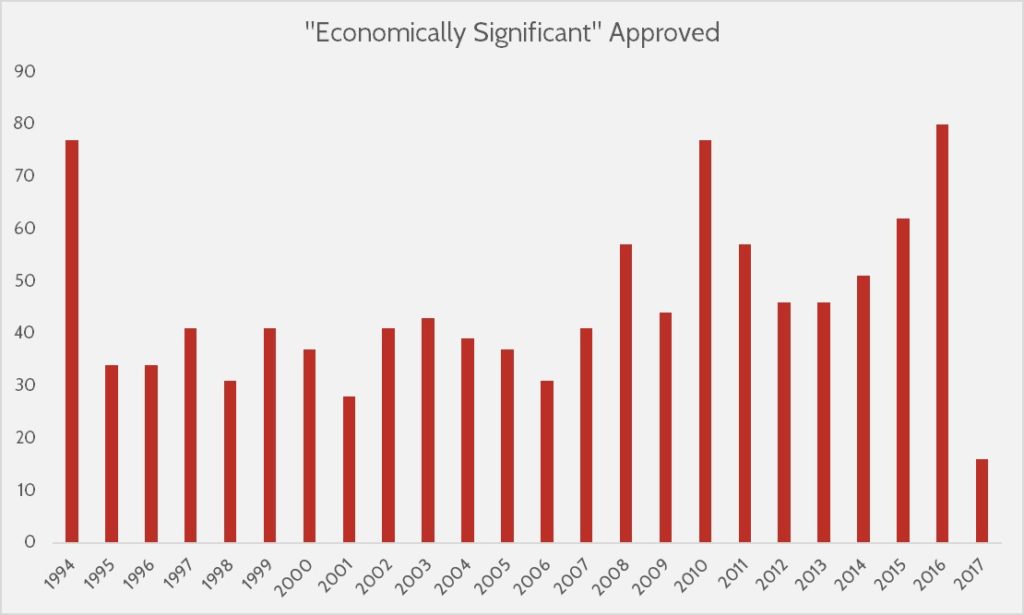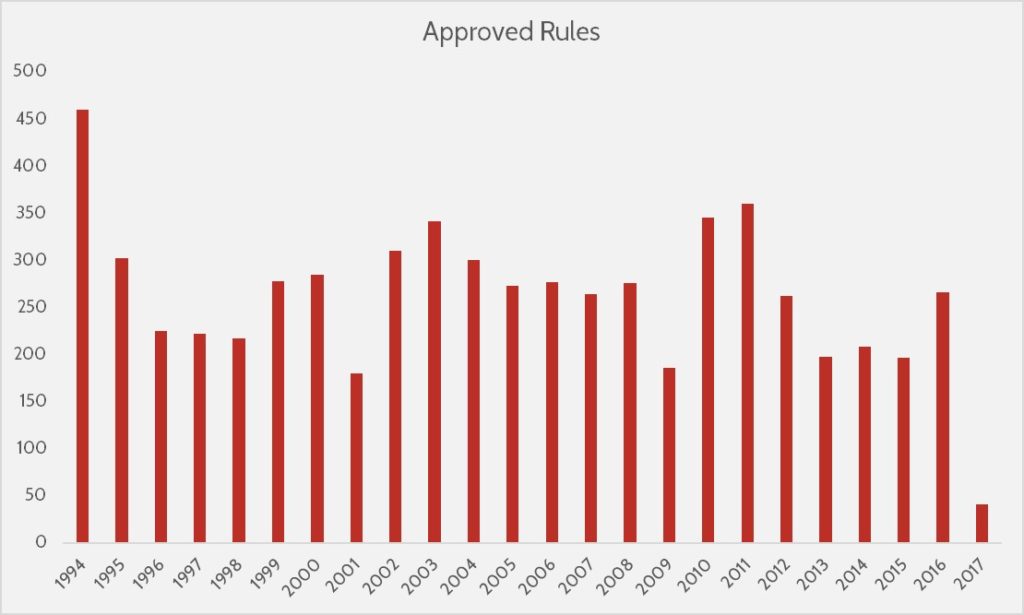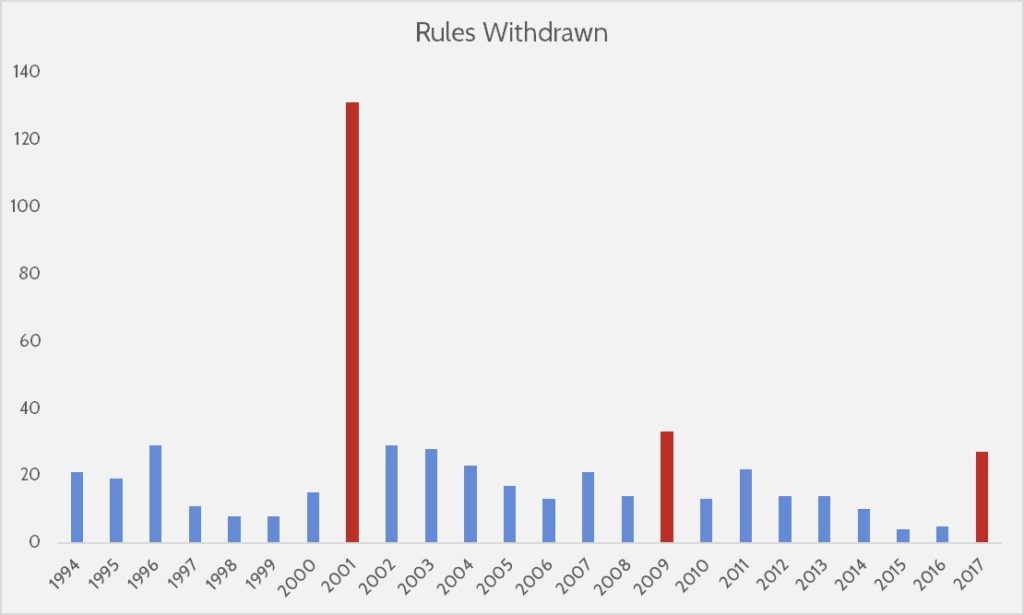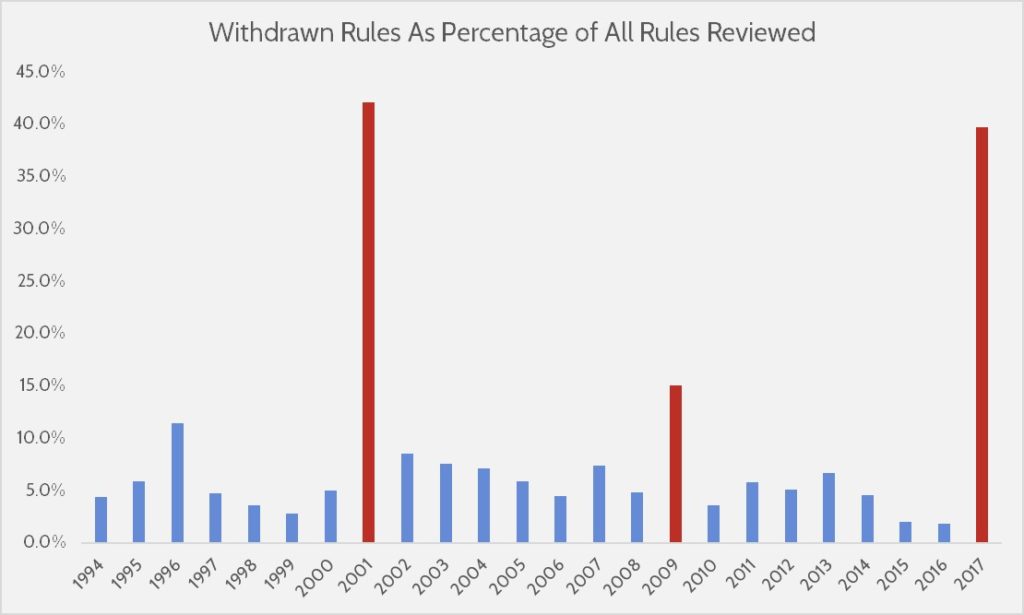Insight
August 8, 2017
Trump On Regulation: The First Six Months
With bold campaign promises and multiple executive orders (EO) , slowing down and rolling back the regulatory state has been one of President Trump’s most significant policy initiatives. Now that his administration has been in power for half of a year, it’s worth reflecting upon the progress the president has made on his regulatory promises. The results are substantial: new regulatory burdens are a fraction of those established under President Obama’s first six months; overall regulatory volume has slowed to historically low levels; and a number of notable deregulatory measures have been initiated.
Regulatory Activity
The following graph compares the regulatory records of Presidents Obama and Trump in their first six months. The figures below come from agency estimates and include all net burdens imposed by executive agencies from January 21, 2009 to July 21, 2009 for President Obama, and January 23, 2017 to July 23, 2017 for President Trump. (The relative start dates are different to allow for the first date in which each administration was in position to control which rules were officially published.) The figures do not include independent agencies as the administrations have no direct control over their rulemaking decisions.
|
Comparison of Executive Agency Action in First Six Months |
||
|
Administration |
Obama | Trump |
| Total Final Rule Costs | $24.4 Billion |
$1.2 Billion |
|
Annual Final Rule Costs |
$4.2 Billion | $378 Million |
| Paperwork Burden | 6,803,249 Hours |
848,239 Hours |
Compared to the Obama Administration, the Trump Administration has imposed: 1/20th of the lifetime costs, 1/11th of the annual costs, and 1/8th of the paperwork. With nearly 6 million fewer paperwork burden hours, that amounts to the workload savings of roughly 3,000 full-time employees.
Regulatory Volume
Earlier this year, AAF examined the trends in how many rules underwent review by the Office of Information and Regulatory Affairs (OIRA). The following charts provide an updated look (through six months instead of four) of such findings. The results are generally similar to the earlier analysis, but staggering nonetheless.
In terms of both overall rulemakings and only those designated as “economically significant” (an annual economic impact of more than $100 million), the Trump Administration has set record lows in overall rulemaking volume. Only 41 rules concluded OIRA reviews and only 16 of those were “economically significant.” For perspective, the next-lowest amounts for either measure were 180 and 28, respectively (both in 2001). The highest amount for either measure was 460 (in 1994) and 80 (in 2016), respectively.
The year 2001, President Bush’s inaugural year, also factors heavily into the amount of rules withdrawn during OIRA review. At 131, it towers over this year’s 27. However, when comparing withdrawn rules as a percentage of all rules sent through OIRA, the gap closes to 42.1 percent for the Bush span versus 39.7 percent for Trump. The year with the lowest number of withdrawals is 2015 with only four. In terms of percentage, 2016 narrowly claims the lowest withdrawals with 1.8 percent versus 2015’s 2 percent.
Deregulatory Activity
The pace of actively deregulatory administrative actions – rather than simply limiting new regulatory actions – has been steady yet relatively modest. In an earlier analysis, AAF found that, through five months, agency actions had produced nearly $130 million in savings. Examining the six-month window, between both final and proposed actions, executive agencies have published roughly $207 million worth of annual cost savings. It’s important to note that part of the issue with deregulatory rulemakings is that they must generally undergo the same process as regulatory rulemakings: issue a proposed rule, solicit and consider comments, and then publish a finalized version. This process takes time, often months to even years. However, there have been notable developments outside of the first six months of purely administrative actions.
The most notable deregulatory actions either have come from legislative action or are still on the horizon. Through the first few months of 2017, Congress and President Trump passed a historic 14 Congressional Review Act (CRA) “resolutions of disapproval.” These resolutions overturned a series of rules, and produced annual cost savings of $1.1 billion ($3.7 billion in lifetime cost savings) that could go towards the administration’s goals set in EO 13,771. Congress is even moving forward with another CRA resolution against a $380 million Consumer Financial Protection Bureau rule. The House passed the resolution. The Senate has 60 session days beginning on July 19 (the rule’s publication date) to act on the resolution under an expedited track that allows final passage via a simple majority rather than the 60-vote threshold required by filing cloture under normal Senate procedure.
While deregulatory administrative actions will take some time, there are significant moves underway. Via executive action, President Trump has ordered the review of at least a dozen substantial rules worth roughly $55.1 billion in total costs. Many of the original rulemakings on this list took years for the previous administration to promulgate, and thus will likely take years to revise or repeal. But there is already movement on some of them. During the last week of July – just beyond the first 6 months window – agencies published proposals to roll back the Obama-era rules on “Waters of the United States” and hydraulic fracturing (commonly known as “fracking”) that could collectively save nearly $350 million annually. Additionally, according to its first “Unified Agenda,” the administration sees the potential for up to $13.5 billion in annual savings from deregulatory actions in the pipeline.
Conclusion
While efforts to reform health care and the tax code largely reign over the headlines, the Trump Administration has had some notable actions on regulations in its first six months. Both the volume and impact of new regulatory burdens have slowed dramatically. In terms of actively revising or repealing past rules, the administration’s greatest achievements have come in working with a unified Congress to pass a record-breaking 14 CRA resolutions. Beyond these first six months, the administration’s ambition is clearly to go even farther and deeper. Only time will tell when and how it gets there.














